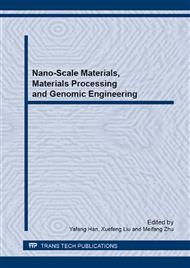[1]
M. Tomkiewicz, Scaling Properties in Photocatalysis, Catalysis Today, 58 (2000)151-159.
Google Scholar
[2]
M. H. Zhang, S. W. Ding, Z. X. Wang, Sn doped nano-TiO2 mesoporous materials synthesized by Chemical self-assembly and its photocatalytic property, Science in China Ser: B Chemistry (in Chinese), 35 (2005)206-211.
Google Scholar
[3]
D. Chen, D. Yang, Q. Wang, Z. Jiang, Effects of boron doping on photocatalytic activity and micro- structure of titaium dioxide nanoparticles, Ind. Eng. Chem. Res., 45(2006)4110-4116.
DOI: 10.1021/ie0600902
Google Scholar
[4]
S. Y. Liu, Q. L. Tang, Q. G. Feng. Synthesis of S/Cr doped mesoporous TiO2 with high-active visible light degradation property via solid state reaction route, Applied Surface Science, 257 (2011) 5544-5551.
DOI: 10.1016/j.apsusc.2011.01.033
Google Scholar
[5]
S. Y. Liu, G. C. Liu, Q. G. Feng. Al-doped TiO2 mesoporous materials: synthesis and photo- degradation properties, J. Porous Mater., 17(2010):197–206.
DOI: 10.1007/s10934-009-9281-8
Google Scholar
[6]
S. Y. Liu, L. D. Wu, Z. X. Zhao, Synthesis of Ni-doped TiO2 mesoporous material via solid- state reaction at low temperature and its kinetics of methyl orange photodegradation, Journal of Inorganic Materials (in Chinese), 24(2009)902-908.
DOI: 10.3724/sp.j.1077.2009.00902
Google Scholar
[7]
W. J. Zhang, B. Yang. Preparation and photocatalytic property of B doped TiO2 photocatalyst, Materials Research Transaction, 26(2012)149-154.
Google Scholar
[8]
T. Siva Rao, T. Abdo Segne, T. Susmitha, Photocatalytic degradation of dichlorvos in visible light by Mg2+-TiO2 nanocatalyst, Advances in Materials Science and Engineering, 2012.
DOI: 10.1155/2012/168780
Google Scholar
[9]
L. D. Wu, S. Y. Liu, W. H. Tang, Solid phase synthesis and photogegradation O-nitrophenol of Sr doped TiO2 mesoporous material.Fine Chemical (in Chinese), 29(2012)751-756.
Google Scholar
[10]
Y. Ide, N. Kawamoto, Y. Bando, Ternary modified TiO2 as simple and efficient photocatalyst for green organic synthesis, Chem. Commun., 2013, DOI: 10.1039/ C3CC41174E.
DOI: 10.1039/c3cc41174e
Google Scholar
[11]
X. B. Chen, S. S. Mao. Titanium dioxide nanomaterials: Synthesis, properties, modifications, and applications. Chem. Rev., 107 (2007)2891-2959.
DOI: 10.1021/cr0500535
Google Scholar
[12]
T. H. De Keijser, E. J. Mettemeijer, H. C. F. Rozendall, Determination of crystallite-size and lattice- strain parameters in conjunction with the profile-refinement method of the determination of crystal structures, J. Appl. Crystallogr., 16(1983)309- 316.
DOI: 10.1107/s0021889883010493
Google Scholar
[13]
R. J. Tayade, R. G. Kulkarni, R. V. Jasra. Transition metal ion impregnated mesoporous TiO2 for photocatalytic degradation of organic contaminants in water, Ind. Eng. Chem. Res., 45 (2006) 5231 -5238.
DOI: 10.1021/ie051362o
Google Scholar
[14]
K. Nagaveni, M. S. Hegde, G. Madras, Structure and photocatalytic activity of Ti1-xMxO2 (M= W, V, Ce, Zr, Fe, and Cu) synthesized by solution combustion method, J. Phys. Chem. B, 108(2004) 20204-20212.
DOI: 10.1021/jp047917v
Google Scholar
[15]
J. C. Yu, J. Z. Zhang, J. C. Zhao. Synthesis and characterization of phosphated mesoporous titanium dioxide with high photocatalytic activity, Chem. Mater, 15(2003)2280- 2286.
DOI: 10.1021/cm0340781
Google Scholar
[16]
J. I. Hubert, A. K. Vasudevan, G. Aruldhas, FTIR as a tool to study high-temperature phase formation in sol-gel aluminium titanate, J. Solid State Chem., 131(1997)181- 184.
DOI: 10.1006/jssc.1997.7371
Google Scholar
[17]
W. Choi, A. Termin, M. R. Hoffmann. The Role of metal ion dopants in quantum-sized TiO2: Correlation between photoreactivity and charge-carrier recombination dynamics, J. Phys. Chem., 98(1994)13669-13679.
DOI: 10.1021/j100102a038
Google Scholar
[18]
M. C. Wu, J. S. Corneille, C. A. Estrada, Synthesis and characterization of ultra-thin MgO films on Mo (100), Chem.Phys. Lett., 182(1991) 472-478.
DOI: 10.1016/0009-2614(91)90110-u
Google Scholar
[19]
X. B. Chen, S. H. Shen, L. J. Guo, Semiconductor-based photocatalytic hydrogen generation, Chem. Rev., 110 (2010)6503–6570.
DOI: 10.1021/cr1001645
Google Scholar
[20]
J. C. Yu, G. S. Li, X. C. Wang, An ordered cubic Im3m mesoporous Cr-TiO2 visible light photocatalyst, Chem Commun, (2006) 2717-2719.
DOI: 10.1039/b603456j
Google Scholar
[21]
Q. T. Zhang. Base on Inorganic materials science. Shanghai: East China University of Science and Technology press, 2007.
Google Scholar
[22]
Y. C. Tang, C. Hu, Y. Z. Wang. Research progress in TiO2 photocatalytic reaction mechanism and kinetics, Progress in Chemistry, 14 (2002) 192-199.
Google Scholar


